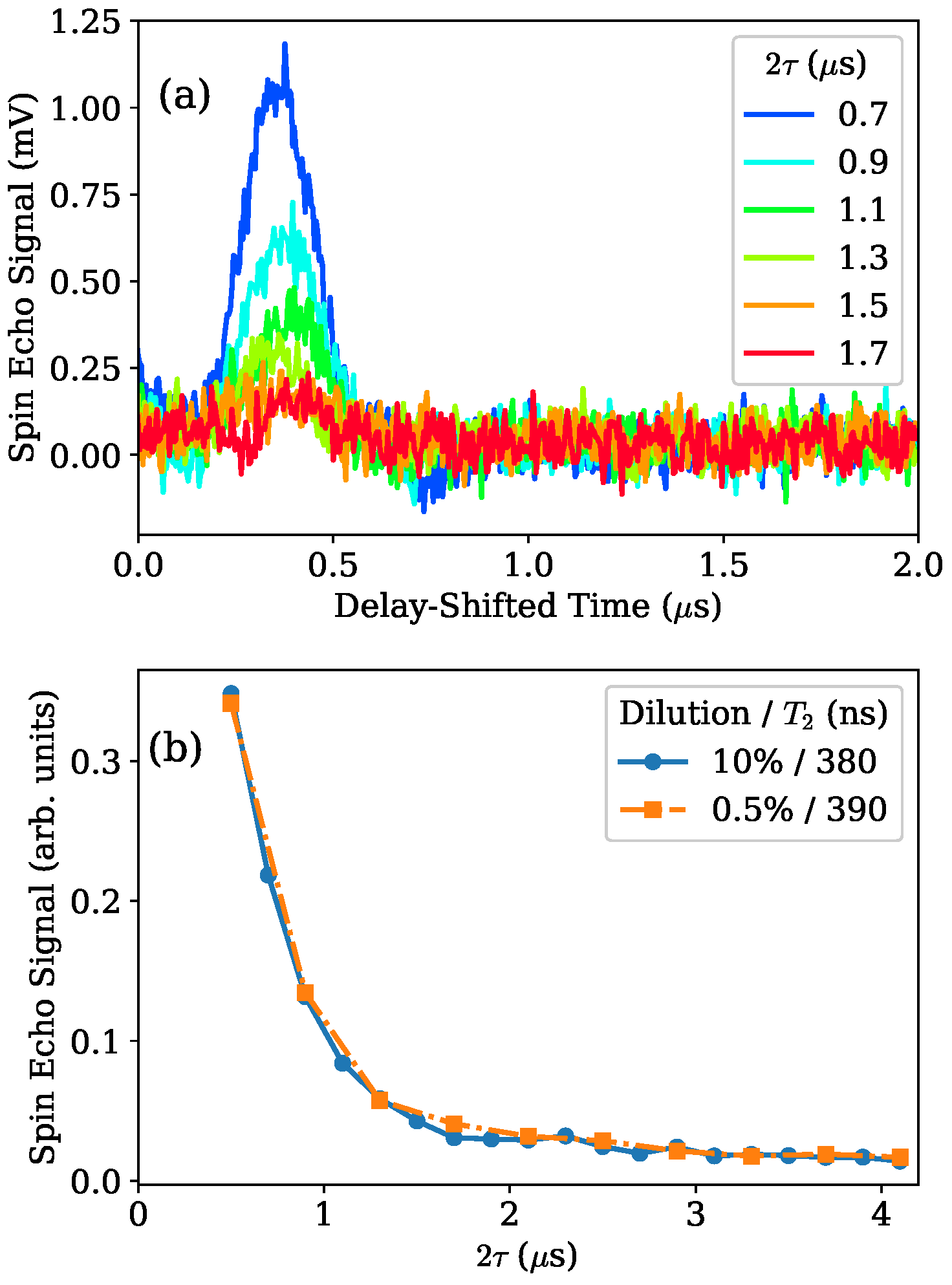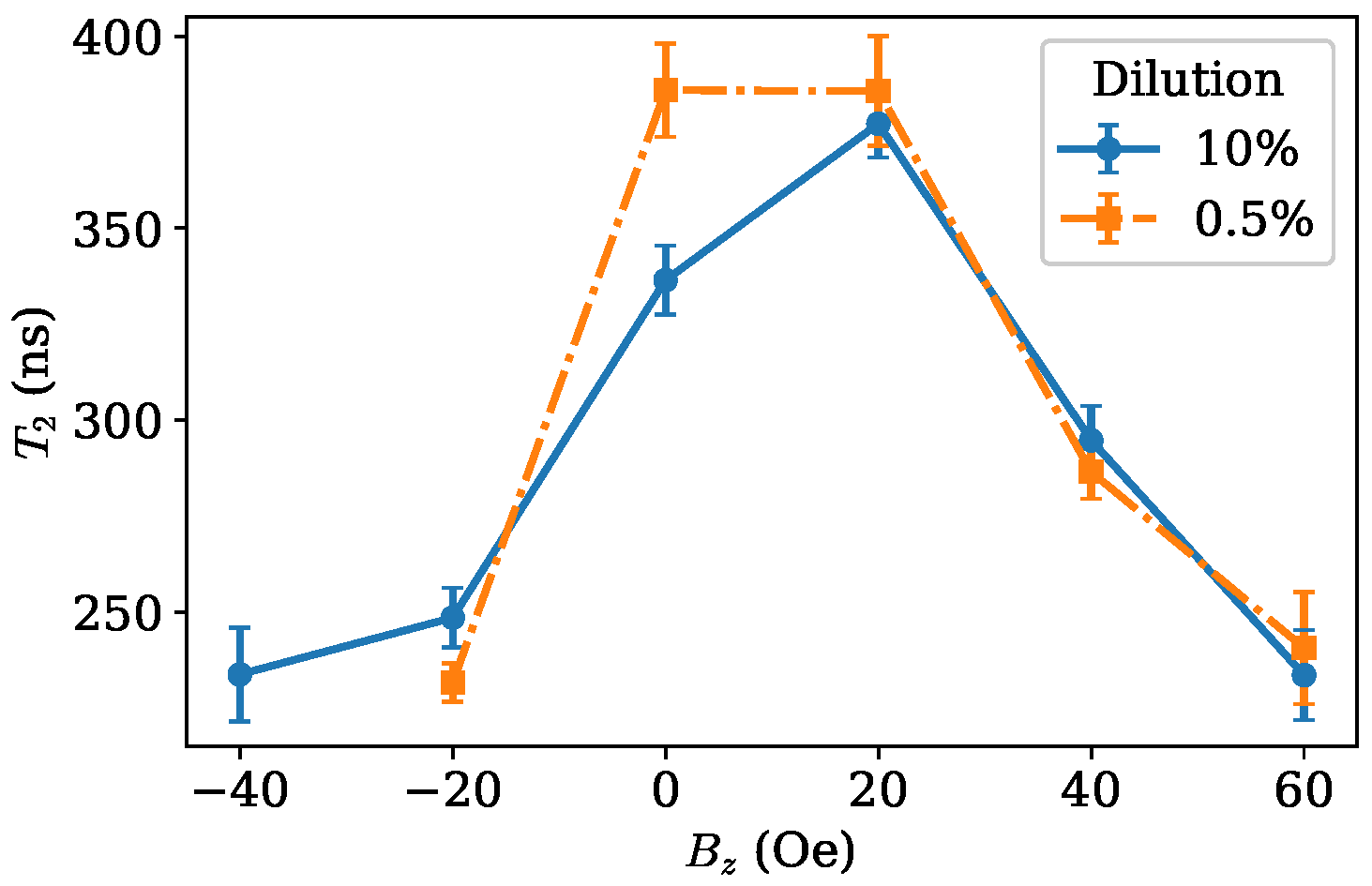A Clock Transition in the Cr7Mn Molecular Nanomagnet
Abstract
1. Introduction
2. Results
2.1. CW Experiments
2.2. Spin Echo Experiments
3. Conclusions
4. Materials and Methods
Supplementary Materials
Supplementary File 1Author Contributions
Funding
Acknowledgments
Conflicts of Interest
Abbreviations
| MNM | Molecular nanomagnet |
| ESR | Electron-spin resonance |
| LGR | Loop-gap resonator |
| CW | Continuous-wave |
| RF | Radio frequency |
References
- Leuenberger, M.N.; Loss, D. Quantum computing in molecular magnets. Nature 2001, 410, 789–793. [Google Scholar] [CrossRef] [PubMed]
- Tejada, J.; Chudnovsky, E.M.; Del Barco, E.; Hernandez, J.M.; Spiller, T.P. Magnetic qubits as hardware for quantum computers. Nanotechnology 2001, 12, 181. [Google Scholar] [CrossRef]
- Friedman, J.R.; Sarachik, M.P. Single-Molecule Nanomagnets. Annu. Rev. Condens. Matter Phys. 2010, 1, 109–128. [Google Scholar] [CrossRef]
- Ardavan, A.; Bowen, A.M.; Fernandez, A.; Fielding, A.J.; Kaminski, D.; Moro, F.; Muryn, C.A.; Wise, M.D.; Ruggi, A.; McInnes, E.J.L.; et al. Engineering coherent interactions in molecular nanomagnet dimers. NPJ Quantum Inf. 2015, 1, 15012. [Google Scholar] [CrossRef]
- Wedge, C.J.; Timco, G.A.; Spielberg, E.T.; George, R.E.; Tuna, F.; Rigby, S.; McInnes, E.J.L.; Winpenny, R.E.P.; Blundell, S.J.; Ardavan, A. Chemical Engineering of Molecular Qubits. Phys. Rev. Lett. 2012, 108, 107204. [Google Scholar] [CrossRef] [PubMed]
- Timco, G.A.; Carretta, S.; Troiani, F.; Tuna, F.; Pritchard, R.J.; Muryn, C.A.; McInnes, E.J.L.; Ghirri, A.; Candini, A.; Santini, P.; et al. Engineering the coupling between molecular spin qubits by coordination chemistry. Nat. Nanotechnol. 2009, 4, 173–178. [Google Scholar] [CrossRef]
- Chiesa, A.; Whitehead, G.F.S.; Carretta, S.; Carthy, L.; Timco, G.A.; Teat, S.J.; Amoretti, G.; Pavarini, E.; Winpenny, R.E.P.; Santini, P. Molecular nanomagnets with switchable coupling for quantum simulation. Sci. Rep. 2015, 4, 7423. [Google Scholar] [CrossRef]
- Timco, G.A.; Faust, T.B.; Tuna, F.; Winpenny, R.E.P. Linking heterometallic rings for quantum information processing and amusement. Chem. Soc. Rev. 2011, 40, 3067. [Google Scholar] [CrossRef]
- Ferrando-Soria, J.; Moreno Pineda, E.; Chiesa, A.; Fernandez, A.; Magee, S.A.; Carretta, S.; Santini, P.; Vitorica-Yrezabal, I.J.; Tuna, F.; Timco, G.A.; et al. A modular design of molecular qubits to implement universal quantum gates. Nat. Commun. 2016, 7, 11377. [Google Scholar] [CrossRef]
- Piligkos, S.; Weihe, H.; Bill, E.; Neese, F.; El Mkami, H.; Smith, G.M.; Collison, D.; Rajaraman, G.; Timco, G.A.; Winpenny, R.E.P.; et al. EPR Spectroscopy of a Family of CrIII7MII (M = Cd, Zn, Mn, Ni) “Wheels”: Studies of Isostructural Compounds with Different Spin Ground States. Chem. A Eur. J. 2009, 15, 3152–3167. [Google Scholar] [CrossRef]
- Lancaster, T.; Blundell, S.J.; Pratt, F.L.; Franke, I.; Steele, A.J.; Baker, P.J.; Salman, Z.; Baines, C.; Watanabe, I.; Carretta, S.; et al. Relaxation of muon spins in molecular nanomagnets. Phys. Rev. B 2010, 81, 140409R. [Google Scholar] [CrossRef]
- Bollinger, J.J.; Prestage, J.D.; Itano, W.M.; Wineland, D.J. Laser-Cooled-Atomic Frequency Standard. Phys. Rev. Lett. 1985, 54, 1000–1003. [Google Scholar] [CrossRef] [PubMed]
- Shiddiq, M.; Komijani, D.; Duan, Y.; Gaita-Ariño, A.; Coronado, E.; Hill, S. Enhancing coherence in molecular spin qubits via atomic clock transitions. Nature 2016, 531, 348–351. [Google Scholar] [CrossRef] [PubMed]
- Takahashi, S.; Tupitsyn, I.S.; van Tol, J.; Beedle, C.C.; Hendrickson, D.N.; Stamp, P.C.E. Decoherence in crystals of quantum molecular magnets. Nature 2011, 476, 76–79. [Google Scholar] [CrossRef] [PubMed]
- Froncisz, W.; Hyde, J.S. The loop-gap resonator: A new microwave lumped circuit ESR sample structure. J. Magn. Reson. 1982, 47, 515–521. [Google Scholar] [CrossRef]
- Portis, A.M. Electronic Structure of F Centers: Saturation of the Electron Spin Resonance. Phys. Rev. 1953, 91, 1071–1078. [Google Scholar] [CrossRef]
- Castner, T.G., Jr. Saturation of the paramagnetic resonance of a V center. Phys. Rev. 1959, 115, 1506. [Google Scholar] [CrossRef]
- Henderson, J.J.; Ramsey, C.M.; del Barco, E.; Stamatatos, T.C.; Christou, G. Control of the inhomogeneity degree by magnetic dilution in crystals of antiferromagnetic molecular rings. Phys. Rev. B 2008, 78, 214413. [Google Scholar] [CrossRef]
- Moro, F.; Kaminski, D.; Tuna, F.; Whitehead, G.F.S.; Timco, G.A.; Collison, D.; Winpenny, R.E.P.; Ardavan, A.; McInnes, E.J.L. Coherent electron spin manipulation in a dilute oriented ensemble of molecular nanomagnets: Pulsed EPR on doped single crystals. Chem. Commun. 2013, 50, 91–93. [Google Scholar] [CrossRef] [PubMed]
- Ardavan, A.; Rival, O.; Morton, J.J.L.; Blundell, S.J.; Tyryshkin, A.M.; Timco, G.A.; Winpenny, R.E.P. Will Spin-Relaxation Times in Molecular Magnets Permit Quantum Information Processing? Phys. Rev. Lett. 2007, 98, 057201. [Google Scholar] [CrossRef]
- Larsen, F.K.; McInnes, E.J.L.; El Mkami, H.; Overgaard, J.; Piligkos, S.; Rajaraman, G.; Rentschler, E.; Smith, A.A.; Smith, G.M.; Boote, V.; et al. Synthesis and Characterization of Heterometallic Cr7M Wheels. Angew. Chem. Int. Ed. 2003, 42, 101. [Google Scholar] [CrossRef]





© 2019 by the authors. Licensee MDPI, Basel, Switzerland. This article is an open access article distributed under the terms and conditions of the Creative Commons Attribution (CC BY) license (http://creativecommons.org/licenses/by/4.0/).
Share and Cite
Collett, C.A.; Ellers, K.-I.; Russo, N.; Kittilstved, K.R.; Timco, G.A.; Winpenny, R.E.P.; Friedman, J.R. A Clock Transition in the Cr7Mn Molecular Nanomagnet. Magnetochemistry 2019, 5, 4. https://doi.org/10.3390/magnetochemistry5010004
Collett CA, Ellers K-I, Russo N, Kittilstved KR, Timco GA, Winpenny REP, Friedman JR. A Clock Transition in the Cr7Mn Molecular Nanomagnet. Magnetochemistry. 2019; 5(1):4. https://doi.org/10.3390/magnetochemistry5010004
Chicago/Turabian StyleCollett, Charles A., Kai-Isaak Ellers, Nicholas Russo, Kevin R. Kittilstved, Grigore A. Timco, Richard E. P. Winpenny, and Jonathan R. Friedman. 2019. "A Clock Transition in the Cr7Mn Molecular Nanomagnet" Magnetochemistry 5, no. 1: 4. https://doi.org/10.3390/magnetochemistry5010004
APA StyleCollett, C. A., Ellers, K.-I., Russo, N., Kittilstved, K. R., Timco, G. A., Winpenny, R. E. P., & Friedman, J. R. (2019). A Clock Transition in the Cr7Mn Molecular Nanomagnet. Magnetochemistry, 5(1), 4. https://doi.org/10.3390/magnetochemistry5010004




